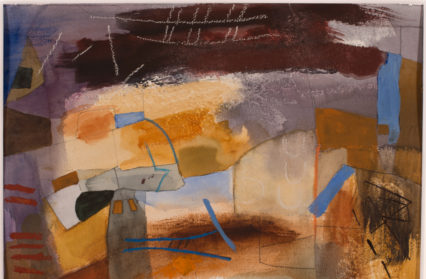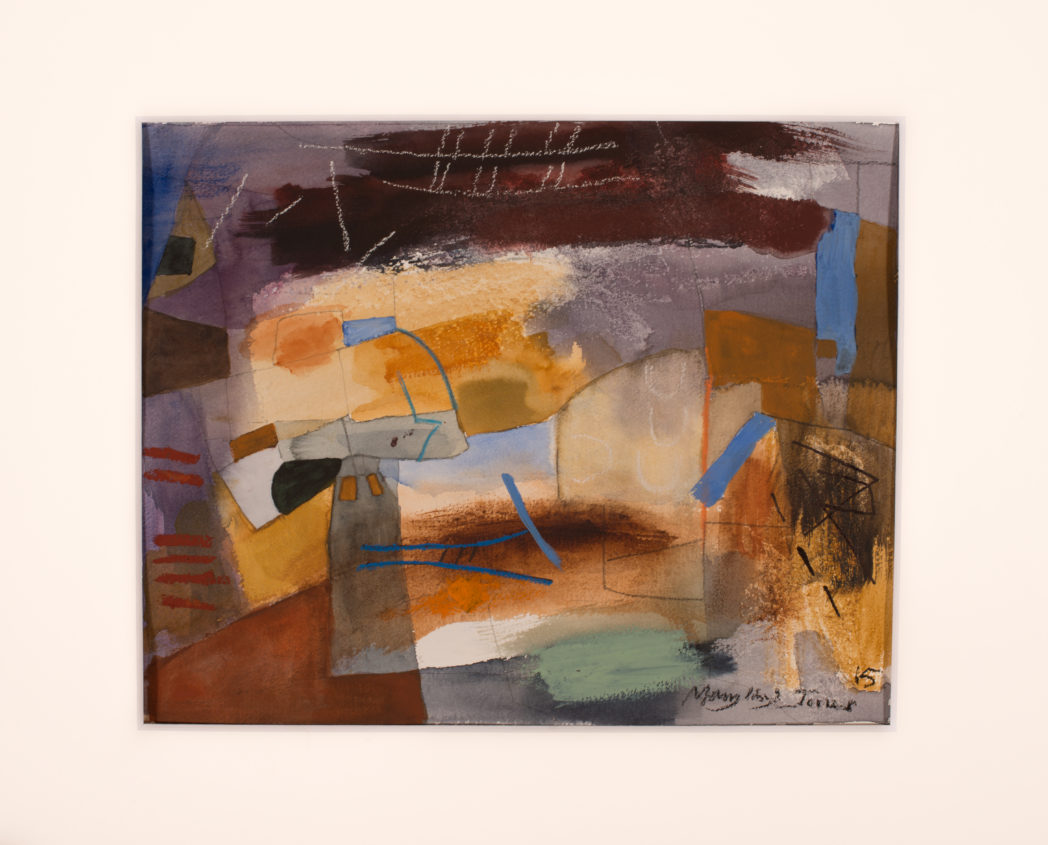Mary Lloyd Jones is an internationally renowned painter and print-maker, and author. As she explains in this revealing article, her work draws on the influence of ancient cultures and languages, and holds a particular preoccupation with the context of her own landscape. Earlier this year Mary Lloyd Jones was the recipient of the Glyn Dwr Award for an outstanding contribution to the Arts in Wales donated by the Lambert family and Y Tabernacl Trust, whose patronage of the Arts is making a difference to West Wales. To this honour she also adds being accepted as a member of Learned Society of Wales in April 2016. In previous years she has received two honorary fellowships to Trinity College Carmarthen and Aberystwyth University and an Honorary Doctorate of the University of Wales, Cardiff.
Mary Lloyd Jones: I have an early memory of the teacher asking what I would like to do when I grew up. I knew then at seven years old that I wanted to become an artist but kept quiet about it, mentioning perhaps waitressing as a possibility. Devil’s Bridge in 1941 had two hotels and a tourist trade.
An artist from my background had no role model. My mother, her sisters and all the grandmothers for generations were carers helping the menfolk and children to survive in a difficult environment. My home despite material poverty had many books including a leather-bound tome bought by subscription by my grandfather, Hanes y Brythoniaid (A History of the British) by Gweirydd ap Rhys. Rhiwmynach (my home) apart from all the newspapers and periodicals also had a set of ten volumes of the Children’s Encyclpedia by Arthur Mee and it was here that I first encountered Italian Renaissance painting. (At the time, the fact that all the paintings were made by dead white males escaped me).
I did not exhibit any painting until I was over thirty. By that time I had spent five years at Cardiff College of Art, got married, had two daughters and had moved after three years from Romford in Essex to Aberarth in Ceredigion. It was in Aberarth that I saw compositions around every corner, the sea, the cliffs, houses and back gardens were a constsnt inspiration, so the paintings flowed, mixed with housework and cooking for my family.
Painting is a form of communication and cannot exist without an audience. Ceredigion in the 60s had one institution that had a gallery, namely The National Library, otherwise visual arts were not supported and did not have the same status as literature and music. So John (my husband) and I decided if we wanted to stay in Ceredigion we would try to bring about more understanding and enthusiasm for painting and related crafts. Our first venture was the Felinfach Summer School which ran for one week in August for three years. This success led to the purchase of Yr Hen Ysgol in Aberbanc where for twenty seven years we tried to create an international hub of activity related to visual expression.
Finding my artistic voice is something which has evolved gradually with certain landmarks of enlightenment. An early key moment was the realisation that contrary to the accepted viewpoint, Wales did have a visual tradition that has become of great importance to me. That inspirational tradition was the work of women producing quilts. I can now see a connection with my great grandmother’s quilt and this provides me with a base on which I can build my own language.
My roots lie in the Welsh language. The need to demonstrate in my compositions the fact of identity is nescessary for me. An interest in letter forms and the beginnings of language led to my own particular direction. In 1993 I saw cup and ring marks carved on boulders on Ilkley Moor and the realisation that man made marks from Prehistory could be integrated into a landscape was a key moment. The carvings on Barclodiad y Gawres and Bryn Celli Ddu on Anglesea frequently find their way into my compositions. My vocabulary now refers to graffiti on walls, the Ogham and Bardic Alphabets and the spirals, zig zags and linear inventions of earlier generations. The direaction of my work was confirmed when I came across the book The Language of the Goddess by Marija Gimbutas on a visit to New York. The book contains thousands of drawings and photographs of signs, symbols and images taken from cultures across the globe revealing a positive female vocabulary which reinforces my own intuitive direction. In my painting I wish to reveal the wealthy deposits of minority languages and to build a bridge between the visual, oral and written means of communication.
Discovering what other artists have said about the creative process, learning which continues for a lifetime, has led to my avid collection of books from all cultures. Learning of the divided brain, the role of the right and left hand hemispheres increased my understanding of the creative process and confirmed the importance of following intuitive decisions in a culture which places more importance on left hand dominance.
Visiting other cultures has always enriched my own art. Brittany, Ireland, France, Italy, North Africa, Tunisia, have all given me opportunities for experiences denied to previous generations of my family. India in particular increased my confidence in the use of colour and led to experiments linking colour to the language of music.
Following my interest in cup and ring marks and archaeological carvings, I was recently able to visit New Mexico to see petroglyphs on volcanic boulders made thousands of years ago by Native Americans, the first people of Turtle Island. In bringing together the art of prehistoric Britain with that of Native Americans my aim is too focus on the attitude of both these cultures towards the natural world.
Now, in the twenty first century with the increasing threat of climate change, much can be learned by looking backwards at the values of earlier peoples who had a respect for the natural world that we have lost.
A particular honour for me in 2016 was to be the recipient of the Glyn Dwr Award for an outstanding contribution to the Arts in Wales donated bythe Lambert family and the Tabernacl Trust, whose patronage of the Arts is making a difference to West Wales. To this honour I can also add being accepted as a member of Learned Society of Wales in April 2016. In previous years I received two honorary fellowships to Trinity College Carmarthen and Aberystwyth University and an Honorary Doctorate of the University of Wales, Cardiff.
– Mary Lloyd Jones
You might also like…
In a brand new series from Wales Arts Review, we ask a selection of Wales’ leading visual artists to present and discuss the work that they identify as the moment they found their ‘voice’. To kick off the series, we speak to one of the most influential and successful Welsh artists of modern times, Shani Rhys James.













